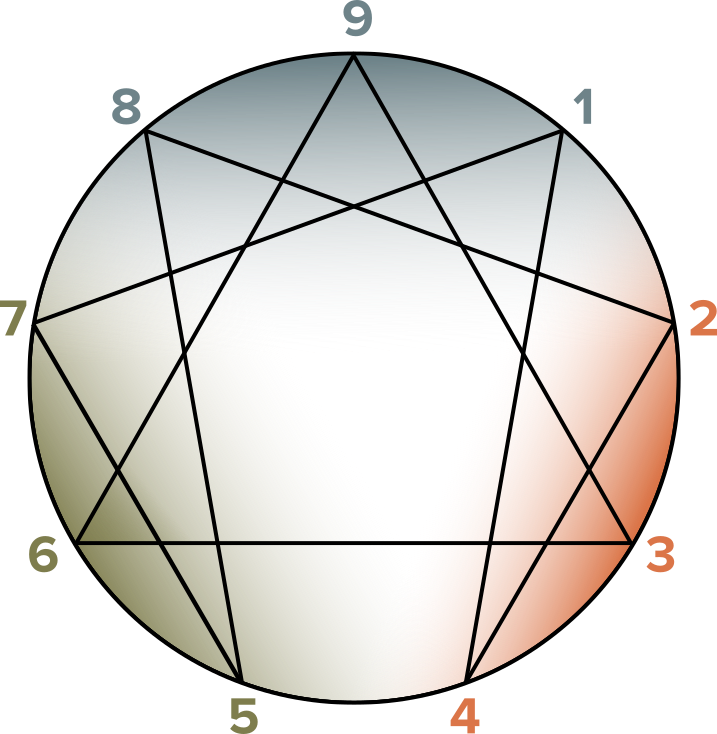What is the Enneagram?
The Enneagram is a nine-pointed symbol (“ennea” is Greek for nine) that represents nine distinct and dynamic ways of seeing and experiencing the world. While it draws from ancient spiritual traditions, the modern Enneagram took shape in the 1960s through the work of George Gurdjieff, Oscar Ichazo, and Claudio Naranjo, each one building upon the work of the other.
You can think of the Enneagram as your internal operating system, illuminating how your personality functions when running on autopilot, through automatic, habitual, and often unconscious, behaviors. No type is better or worse than another; each holds its own strengths and challenges. The Enneagram helps us remember that not everyone sees or experiences the world the way we do.
Each of the nine types is shaped by specific core motivations, emotional responses, basic fears, patterns of attention, and potential blind spots. While we may express behaviors of every type, one type serves as our “home base,” and is the lens through which we most naturally perceive and respond to life. This core type gives structure to our personality, or ego, and colors our inner landscape.
When used in inner work, the Enneagram helps us recognize these automatic patterns and find ways to change course. That’s because we are so much more than our personality. And, it means that the Enneagram is so much more than typology. In fact, our personality is what shows up when we are not in Presence. The Enneagram offers nine unique paths back to Presence.
Use the links below to explore more aspects of the Enneagram and the wisdom it offers. For a much deeper dive into its history, this overview from The Enneagram Institute is incredibly thorough.
FAQs
-
Only you can determine your Enneagram type. There are online tests, but I would be cautious of putting too much stock in the results (see question below).
I find that there are 4 strong ways to learn your type.
Teaching: Listening to an Enneagram teacher teach on all 9 types. When you start to get that feeling that they’re describing you, then you’ve likely found your type.
Panels: Another way that teachers explain the Enneagram is through type panels. Because the expression of type can vary, when an Enneagram teacher facilitates a panel, you can hear from people of that type to share their experience of living as that type.
Reading: There are several reputable resources (books and websites) where teachers have written about the 9 types. Read about the types and pay attention to the different motivations and focus of attention.
Typing Interview: If you’re still struggling, schedule a typing interview. In a 45-60 minute conversation, I will guide you through structured questions to discern patterns of behavior and core motivations. At the end of the typing interview, I will offer 2-3 possible types and some further resources. We can then discuss your thoughts on the suggestions.
-
Discovering your type is only the beginning of the journey. Often people learn their type and stop there. One of my teachers says that working with the Enneagram is like taking a hike. Learning our type is just getting to the trailhead. Working with the Enneagram is actually taking the hike.
A practical first step is to begin noticing your behaviors and the patterns of your type in daily life. With practice, you’ll start to recognize when your type is pulling you out of Presence—and in those moments, you gain the freedom to choose a different response.
But…awareness is only the first step.
-
No. The expression of our type can vary from moment to moment, but we always return to our core type, its motivation, worldview, fears, and focus of attention. We have access to the energy of our wings and resource points but our type does not change.
-
I recognize people’s hesitancies to personality assessments or tools because they “don’t want to be put in a box” or labeled.
The Enneagram doesn’t put you in a box. Rather, it shows you the box you’re already in, and the way out. It provides liberation from the unhelpful patterns of our personality that have kept us confined for so long.
-
There are a number of tests online that you can take. But, do so with caution. Many tests focus on behavior. The Enneagram focuses on motivation. Tests are easy to manipulate based on your mood when you take it, or how you would prefer to be.
That being said, there are a few tests that are more accurate than others:
-
There are many reasons. The Enneagram is a dynamic system. The expression of our type varies at different times in our life. We have access to the energy of our wings and resources points. We may be at varying levels of self-awareness. We may be in seasons of challenge. For more information, check out the Dynamic Enneagram page.


